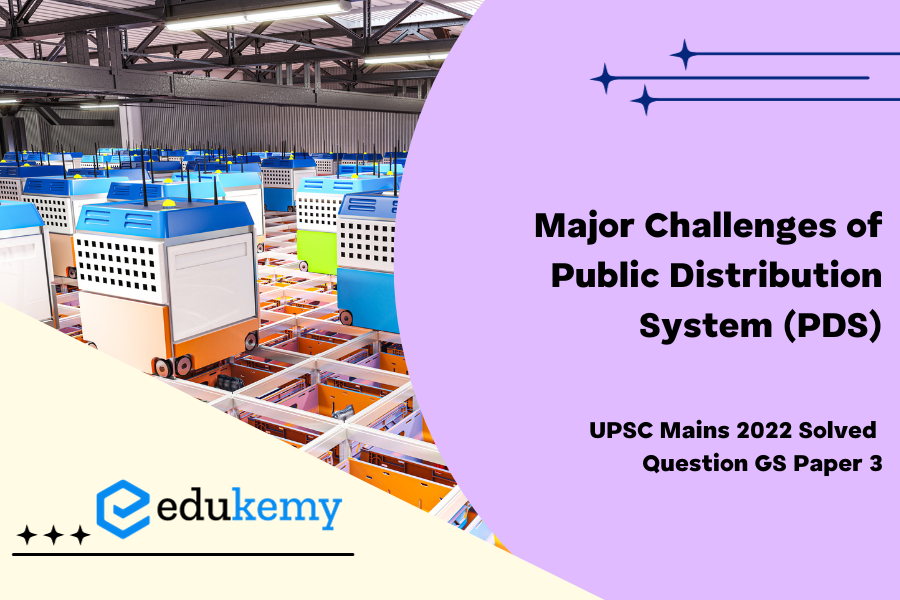India’s Public Distribution System (PDS) faces challenges like leakages, corruption, and inefficiencies. Reforms such as digitization, technology integration, and stringent monitoring can enhance transparency. Strengthening logistics, targeting beneficiaries accurately, and implementing anti-corruption measures are essential to make PDS effective, ensuring efficient food distribution.
UPSC Mains General Studies Paper – 3 Mains 2022
UPSC Mains Civil Services IAS Exam Question Paper – 2022
Contents
Approach
- Introduce with emphasising the keywords ”Public Distribution System(PDS), with objective and functions in brief.
- Detailing with the constraints to implement as major challenges of PDS in India
- Mention the wayforward to make it effective and transparent to overcome the challenges.
- Accordingly conclude it .
Introduction
India’s Public Distribution System is the largest food security programme in the world, which covers nearly 60% of population and cost of Rs.1.45 trillion -close to 1.4% of the national income.
Public Distribution System is the public rationing system of India which is administered by the Ministry of Consumer Affairs , Food and Public Distribution.
Body


The Public Distribution System (PDS) in India faces several major challenges:
- Leakage and diversion: One of the primary challenges is the diversion of subsidised food grains and essential commodities meant for the intended beneficiaries. Leakage and corruption within the system lead to these items not reaching the intended recipients.
- Inaccurate targeting: There are issues with identifying and targeting the deserving beneficiaries accurately. Inclusion and exclusion errors result in eligible individuals not receiving benefits, while some who are not in need may receive them.
- Weak infrastructure and logistics: Inadequate storage facilities, inefficient transportation systems, and lack of last-mile connectivity contribute to spoilage of food grains and delays in reaching beneficiaries.
- Lack of transparency and accountability: The lack of transparency in the functioning of the PDS hampers effective monitoring and accountability. Limited access to information on distribution, entitlements, and beneficiaries makes it difficult to detect and address irregularities.
To make the PDS more effective and transparent, the following measures can be implemented:
- Technology-driven solutions: Leveraging technology can help improve transparency and accountability. Implementing biometric authentication, smart cards, and digitized databases can aid in accurate beneficiary identification, real-time tracking of supplies, and monitoring of distribution.
- Strengthening grievance redressal mechanisms: Establishing efficient grievance redressal mechanisms allows beneficiaries to report complaints and seek resolutions promptly. This ensures accountability and addresses any issues related to entitlements or service delivery.
- Aadhaar integration: Linking the PDS with Aadhaar, a unique identification system, can help eliminate duplicate and ghost beneficiaries, reducing leakage and targeting errors.
- Enhanced disclosure and transparency: Regularly sharing information such as beneficiary lists, entitlements, and distribution data promotes transparency. Making this information accessible to the public allows for scrutiny and helps detect irregularities.
- Strengthening monitoring and audit systems: Implementing robust monitoring systems, including independent audits, helps track the movement of goods, distribution processes, and performance of intermediaries. This helps identify and deter corruption and irregularities.
- Capacity building and training: Providing adequate training and capacity-building programs for PDS officials improves their knowledge and skills in implementation, management, and handling of technology-driven solutions.
Conclusion
Addressing these challenges and implementing the suggested measures can enhance the effectiveness and transparency of the PDS in India, ensuring that the intended beneficiaries receive their entitlements and reducing leakages and corruption in the system.
In case you still have your doubts, contact us on 8792740517.
For UPSC Prelims Resources, Click here
For Daily Updates and Study Material:
Join our Telegram Channel – Edukemy for IAS
- 1. Learn through Videos – here
- 2. Be Exam Ready by Practicing Daily MCQs – here
- 3. Daily Newsletter – Get all your Current Affairs Covered – here
- 4. Mains Answer Writing Practice – here


